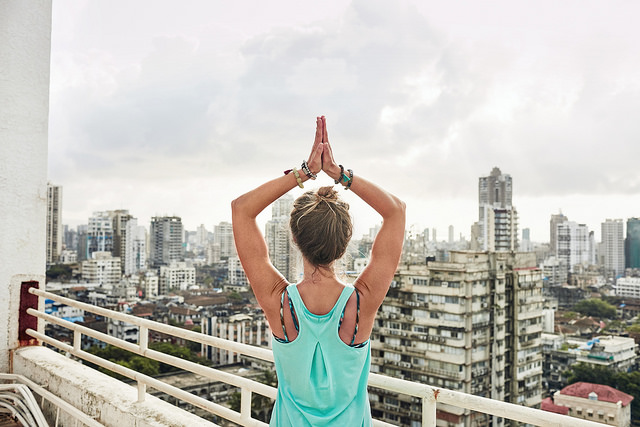Let’s get real. A year ago, meditating with intention consisted of me going to a one-hour yoga class a few times a week and lying down in shavasana repeating an intention the yoga instructor had already drilled in me at the beginning of class.
Fast forward to today, countless incredible meditation workshops later, and I am actually writing and sharing with you:
I have become a meditating junkie who loves setting daily intentions (no yoga mat required).
Here’s the thing. My mind is loud! It races with ideas, thoughts, to-do lists, my problems, other people’s problems—you get the idea. I used to think I was too busy to sit still, and now I will literally clear my schedule to fit in a meditation class and even wake up earlier just to squeeze in a 10-minute meditation after my morning workout.
“You should sit in meditation for twenty minutes every day, unless you’re too busy; then you should sit for an hour.” ~ Zen Adage
Meditation has gotten me hooked, bringing me to a space where my mind no longer races, where my thoughts are no longer clouded by outside interference. It’s a place where I can give my full and undivided attention.
I’ve also learned through meditation the subtle power of intention. I now look at intention as a way of filling the gap between what I want (my goals) and how I intend (the road-map) to get there. It’s deliberately choosing how I want to approach my day regardless of what I accomplish or what the day throws my way. An intention is a desire with a purpose, with no strings attached.
To help you navigate the powerful combination of meditation and intention, I’ve laid out some things to keep in mind before, during, and after meditation. (You’ll probably be surprised at the best time to set that intention!)
What to do before:
Ever get hit with a source of inspiration through something you read or an invigorating conversation you had with a close friend? Those are my favorite times to jot down some key words or phrases that inspire me or that I want to explore further on my own.
What about those moments of uncomfortable emotions like pain, hurt, or disappointment? You probably guessed it, these feelings are just as critical to understand. I find that when something upsets me, I set the intention to meditate on my own feelings toward that situation. It’s not about staying in that place forever; it’s about revisiting it to find the lesson and then letting it go.
So in one scenario you can choose the intention to be a more courageous adventurer and risk taker and in another you can choose to seek understanding from your own emotions.
Tip: Writing your intentions down and remembering to keep them simple and from a place of “have” versus “need” is key.
During Meditation:
If you’re five or 15 minutes deep into your meditation, this is definitely not the time to be setting an intention. Once you’ve started to meditate, this is your time to focus on your breath and that moment.
The most common intention for everyone before starting is actually this: to be present. When our minds wander, much like mine has before, we stress about the fact that we aren’t there, or present. In doing so, we are basically sabotaging ourselves.
Just imagine someone starting to meditate with the intention to feel more at peace while repeating the word: peace, peace, peace, over and over again as their mind wanders to the million and one things that stress them out. The key here is to acknowledge thoughts with gratefulness for showing up and letting them go in your exhale to create the space for you to return to your next breath.
“Inhale calm, exhale stress”—my favorite motto.
Meditation has taught me a lot about the importance of surrendering. Much like in life, we can’t control what every moment will bring no matter what our intention is. In meditating we learn to surrender to the thoughts that come up. Instead of fighting to push them out, we acknowledge them and let them go to recreate the space for something new.
Meditation takes practice because it takes patience with yourself and the process, and it takes openness—knowing you may not always get the answer you want to hear. The powerful part of meditation is there is no ego here, it is you in your most authentic self.
The moments after:
Deepak Chopra wrote an article where he says, “The best time to plant your intentions is during the period after meditation, while your awareness remains centered in the quiet field of all possibilities.” He goes on to say that after you’ve set it, you should “let it go—simply stop thinking about it.” Meditation gurus probably already know exactly what he’s talking about.
What better time to set a meaningful and real intention than from a place of peace and contentment? What’s more important is his emphasis on setting it and letting it go. Because, much like the futile idea of setting an intention during meditation, how can you receive what you’re requesting if you’re too busy holding onto it all day?
In my mind, there is no wrong or right way to do this, the most important thing is to find what works best for you.
Author: Melissa Rodriguez
Editor: Catherine Monkman
Image: Indiska/Flickr







Read 1 comment and reply